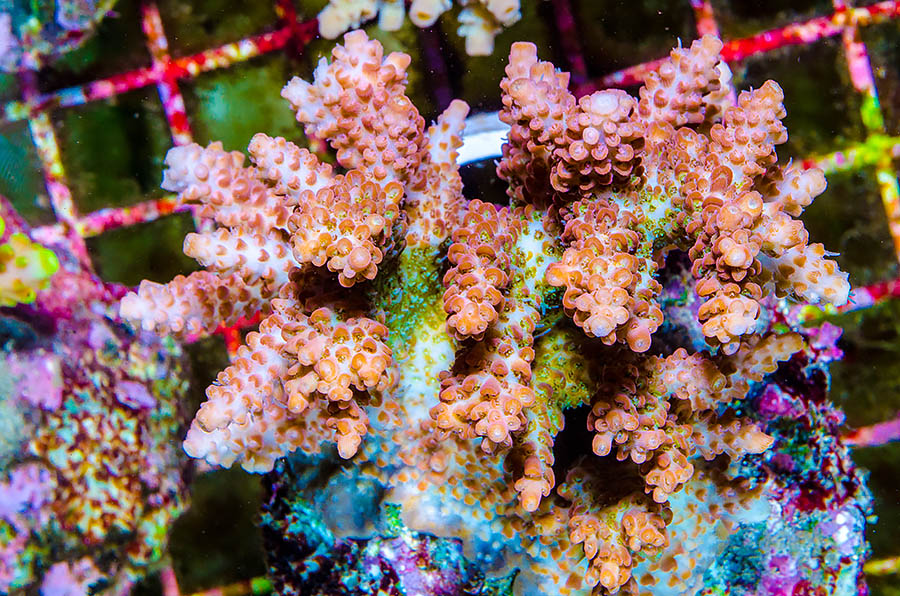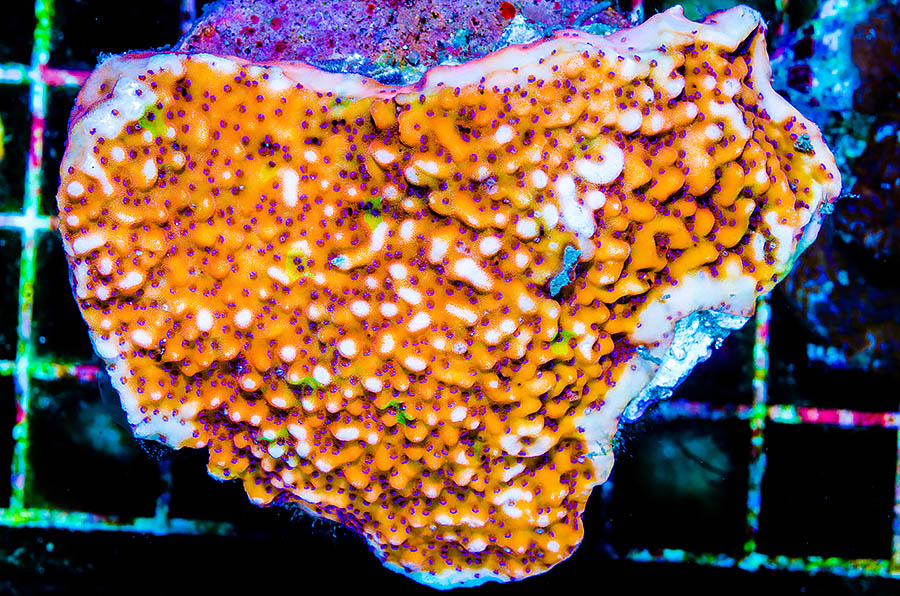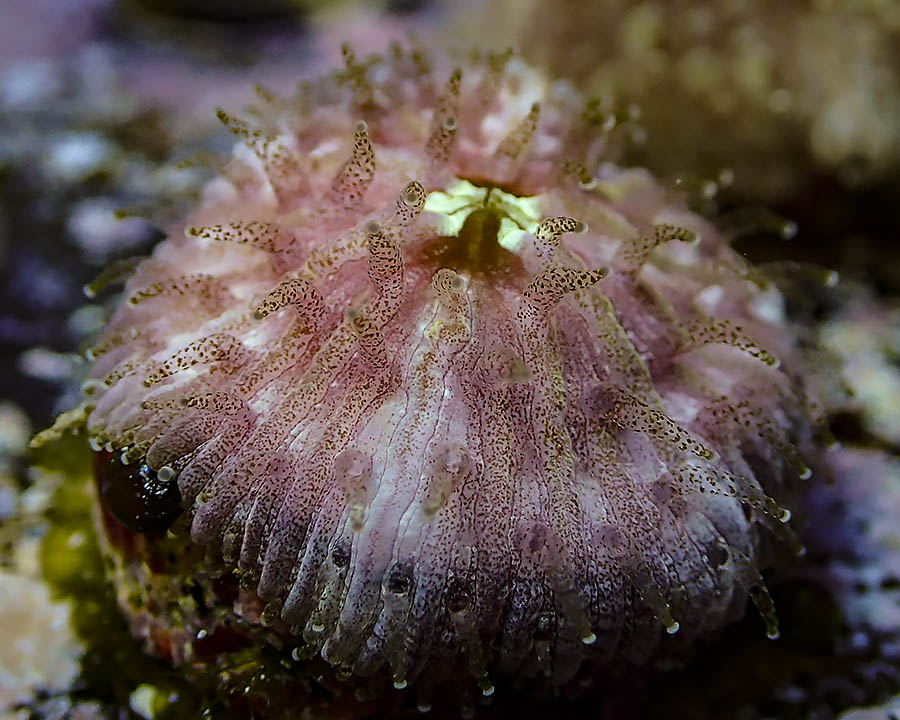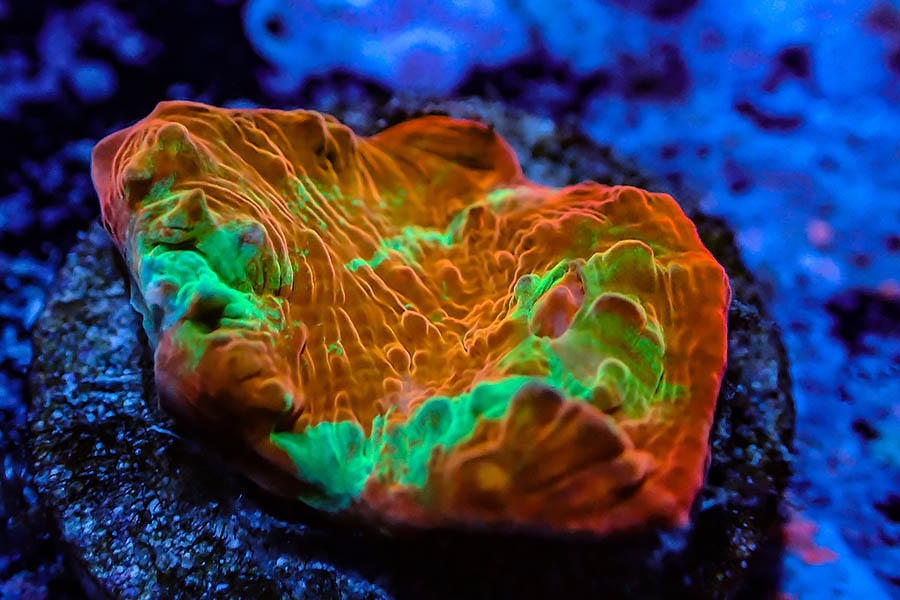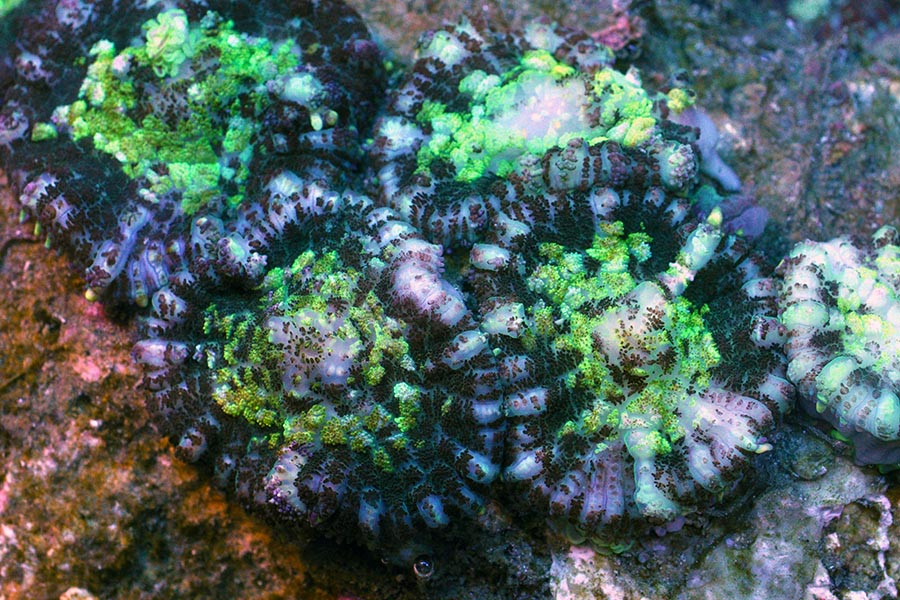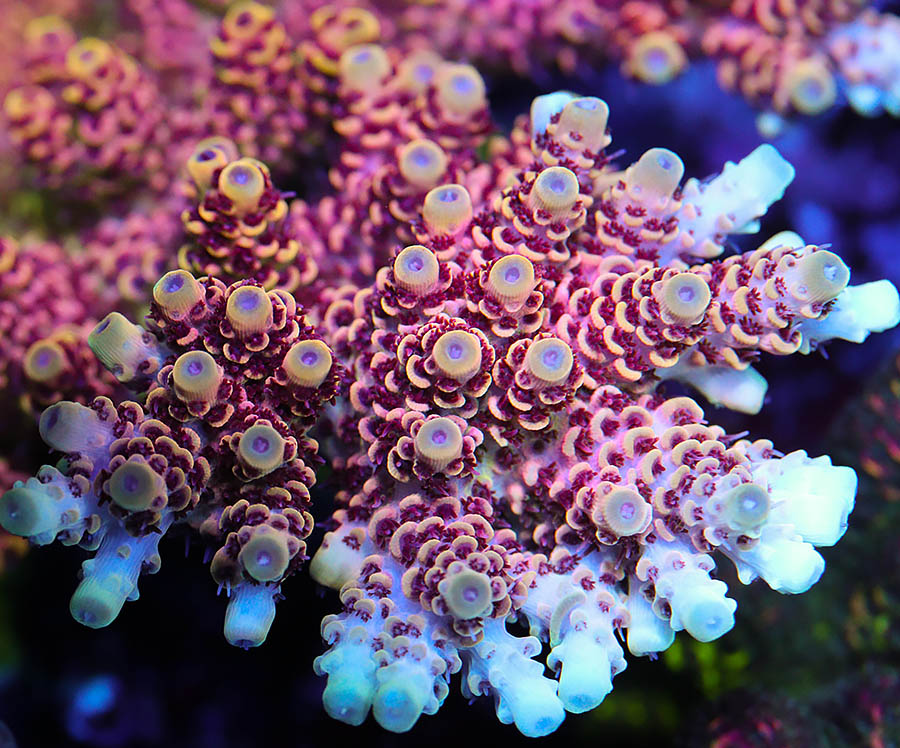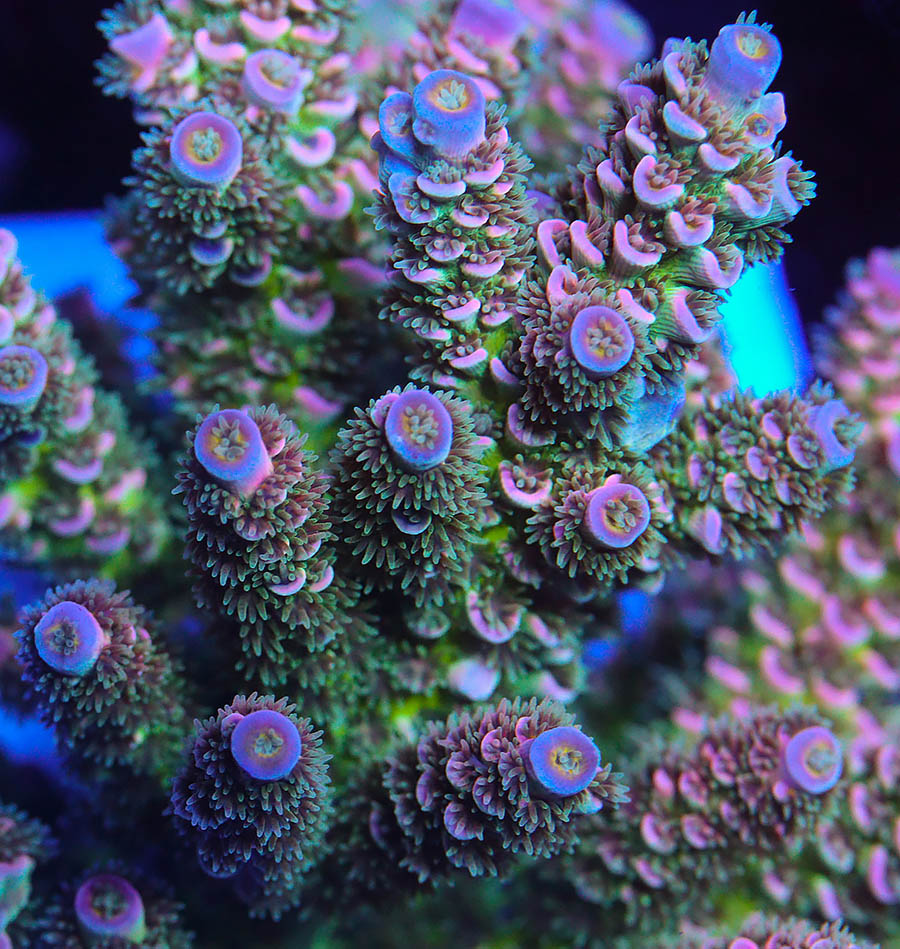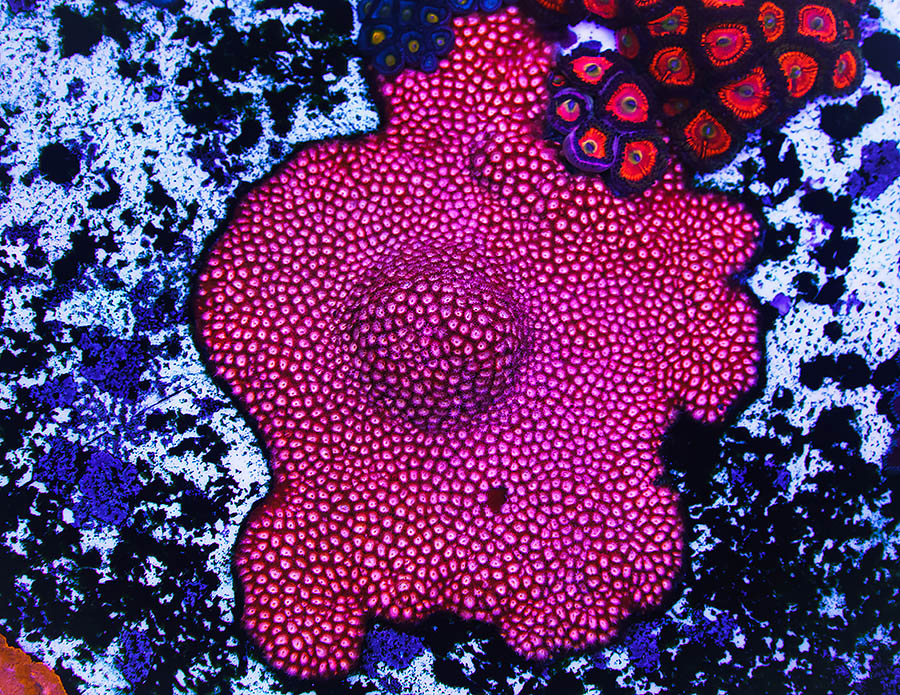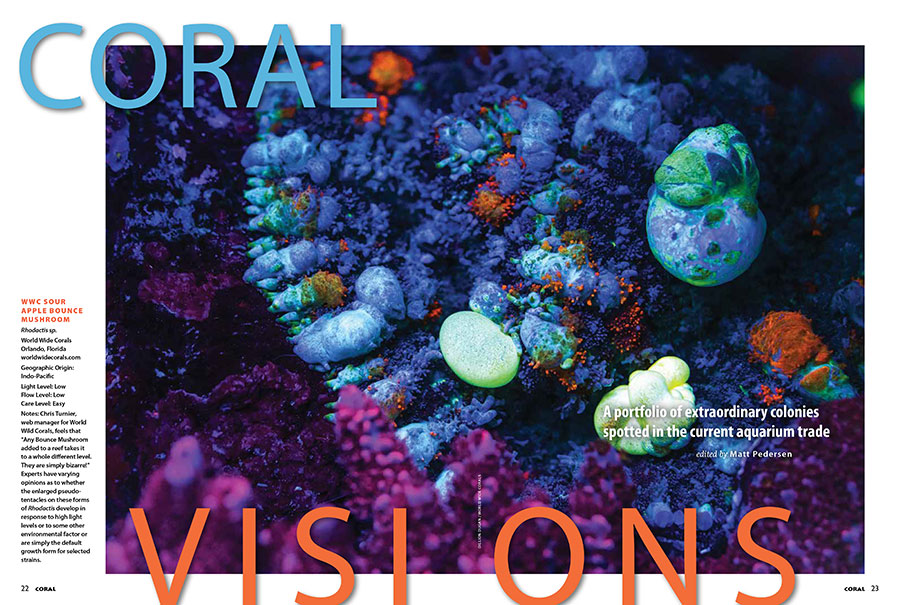
Looking like a deep space image captured by the Hubble Telescope, this otherworldly macro photograph of the World Wide Corals Sour Apple Bounce Mushroom opens the May/June edition of CORAL VISIONS. You’ll have to turn the pages of the magazine to see what else made it into print this issue!
Turn the pages of your new issue to catch a glimpse of some of the most astonishing corals on the market right now, and see even more that didn’t make the final cut in this exclusive ONLINE BONUS.
For each new issue, CORAL’s editors reach out to livestock collectors, importers, and coral farmers around the planet, asking them to share their unique or unusual introductions to the aquarium trade.
We are always overwhelmed by the responses we get; there is always something our veteran staff has never seen before, something that makes jaws drop. But for each coral that ultimately gets showcased in the pages of the magazine, many worthy corals, presented by some of the best coral photographers, must be passed over.
What becomes of the numerous submisisons that don’t make it onto the printed page? Herewith: a look at some exceptional coral morphs and cultivars that did not make it into the current issue, but that we suspect you will find worthy of a second look.
To get the print edition of VISIONS, look for a copy of CORAL Magazine at your LFS or Barnes & Noble bookstore, and see the corals that beat out the ones below. Comments or suggestions to our editors may be posted below.
—Matt Pedersen
Bali Aquarium Solytariensis
Acropora solytariensis
Bali Aquarium
Denpasar, Bali, Indonesia
baliaquarium.net
Geographic Origin: Bali; maricultured colony
Light Level: High
Flow Level: High
Care Level: Difficult
Notes: This is a very fast-growing species that loves high flow and bright light. Bright green tentacles will open up very easily if offered food regularly, giving it a furry appearance.
Photo Credit: Bali Aquarium
Montipora sp.
Bali Aquarium
Denpasar, Bali, Indonesia
baliaquarium.net
Geographic Origin: Bali; maricultured colony
Light Level: Low
Flow Level: Moderate
Care Level: Moderate
Notes: This coral was originally found on a Bali reef at a moderate depth on a vertical drop-off. Note the particular coloration of the polyps themselves, which appear to be bi-colored. While this Montipora cultivar is already pretty exciting, this particular colony, found in our coral farm, may be one of a kind; note the splashes of green coloration within the red base color. Could this be a new “grafted” Monti?
Photo Credit: Bali Aquarium
Mummy Eye Disc
Fungia sp.
A&M Aquatics
Lansing, Michigan
amaquatics.com
Geographic Origin: Indo-Pacific
Light Level: Moderate-High
Flow Level: Moderate
Care Level: Easy
Notes: The Mummy Eye Disc is an interesting aquacultured Fungia disc coral, propagated in-house at A&M Aquatics. The small specimen shown above will become a bit richer in coloration with age.
PhotoCredit: Bill Backus
Red Volcano Chalice
Echinophyllia sp.
A&M Aquatics
Lansing, Michigan
amaquatics.com
Geographic Origin: Indo-Pacific
Light Level: Low
Flow Level: Low
Care Level: Moderate
Notes: Feeding this chalice coral frequently will boost the already vibrant coloration seen here.
Photo Credit: Bill Backus
Alien Deduction
Rhodactis sp.
Quality Marine
Los Angeles, California
qualitymarine.com
Geographic Origin: Indonesia
Light Level: Low to Moderate
Flow Level: Low: Gentle and Indirect
Care Level: Variable
Notes: Like most Rhodies, these aren’t that hard to keep alive, but they will compete with other corals chemically and can lose their stark coloration in that fight. Aggressive chemical filtration can help this, but then the risk of nutrient levels dropping too low is real. This can be a fine balance. One option that could make their care a bit easier would be to consider species-specific aquarium, or at least a genus-specific community.
Photo Credit: Quality Marine
LRO Bonita Applebum
Acropora millepora
Living Reef Orlando
Orlando, Florida
livingreeforlando.com
Geographic Origin: Bali, Indonesia
Light Level: High
Flow Level: High
Care Level: Difficult
Notes: The hints of pinkish-orange on the radial corallites become more prominent in higher light.
Photo Credit: Ann Yoang
LRO Kiss Of Death
Acropora tenius
Living Reef Orlando
Orlando, Florida
livingreeforlando.com
Geographic Origin: Bali, Indonesia
Light Level: High
Flow Level: High
Care Level: Difficult
Notes: This piece loves a lot of flow; the Kiss Of Death’s polyps will extend much farther with higher flow. When offered higher flows, this cultivar also can develop rainbow-colored corallites.
Photographer Credit: Ann Yoang
WWC Peppermint Cyphastrea
Cyphastrea sp.
World Wide Corals
Orlando, Florida
worldwidecorals.com
Geographic Origin: Indo-Pacific
Light Level: Low
Flow Level: Moderate
Care Level: Easy
Notes: Our WWC Peppermint Cyphastrea is a fast-growing encrusting coral that will cover most surfaces with undeniable beauty!
Photo Credit: Dillion Dugan
For those new to our CORAL Visions series, take note: Recognized coral vendors furnish their own subjective and generalized rating on a particular coral’s care requirements. Out of respect for the expertise of these professional aquarists, and with the realization that different cultivars of the same coral species may have different needs, we refrain from attempting to equalize or normalize these ratings between individuals of the same species or type. Therefore, when comparing entries, you might see different ratings for the same coral’s light, flow, or care needs.
